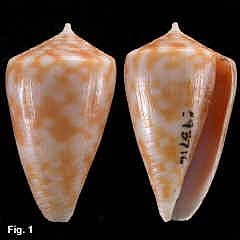|
|
|
|
Conus sydneyensis Sowerby, 1887 Description: Shell medium in weight, sides straight or slightly convex. Lower half or third of body whorl with widely spaced spiral grooves, stronger towards the base. Remainder of body whorl smooth apart from faint axial growth lines. Shoulder angled, spire straight or concave. Spire whorls with 2 or 3 spiral ribs per whorl, becoming obsolete on the last whorl of some shells. Background colour white or cream, ornamented with irregular patches of orange-brown, which may join to form axial or oblique streaks. Interior pale pink. Size: Up to 35 mm in length. Distribution: Endemic to Australia; Ballina, NSW, to Stanwell Park, NSW. Habitat: Subtidal, 55-170 m. Uncommon. Comparison: Among the NSW deep water cones the closest species is C. cyanostoma. There are three characters that distinguish the two species. In sculpture, C. cyanostoma has most or all of the body whorl with spiral grooves, but in C. sydneyensis these are restricted to lower half or third. C. cyanostoma is smaller - up to about 24 mm, compared to 34 mm for C. sydneyensis. In habitat, C. sydneyensis is recorded only from 55-170 m, but for C. cyanostoma, about two thirds of specimens are beach collected, the remainder being down to 183 m. Synonymy: This species has been known as Conus illawarra (Garrard, 1961), but Moolenbeek (1988) has shown this to be a synonym of C. sydneyensis. Fig. 1 Off Broken Bay, NSW (C.093716) |
